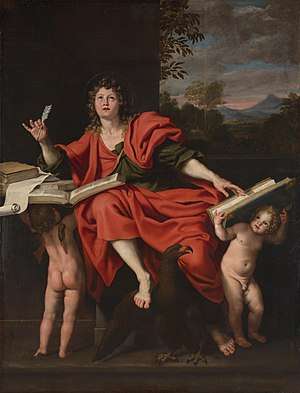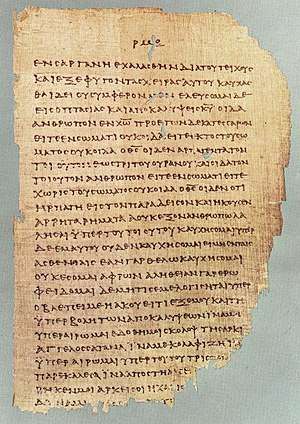First Epistle of John
| Part of a series of articles on |
| John in the Bible |
|---|
 |
| Johannine literature |
| Authorship |
| Related literature |
| See also |
The First Epistle of John, often referred to as First John and written 1 John or I John, is the first of the Johannine epistles of the New Testament, and the fourth of the catholic epistles. It is attributed to John the Evangelist, traditionally thought to be the author of the Gospel of John and the other two Johannine epistles. This epistle was probably written in Ephesus in AD 95–110.[1] The work was written to counter docetism, which is the belief that Jesus did not come "in the flesh", but only as a spirit. It also defined how Christians are to discern true teachers: by their ethics, their proclamation of Jesus in the flesh, and by their love.[1]
Content
The main themes of the epistle are love and fellowship with God.[2][3] The author describes various tests by which readers may ascertain whether or not their communion with God is genuine, and teaches that the proof of spiritual regeneration is a life of active righteousness.[4] It also distinguishes between the world (which is full of evil and under the dominion of Satan) and the children of God (who are set apart from the world).[5]
Style
The epistle is not written in the same form as the other biblical epistles, lacking an epistolary opening or conclusion.[6] The epistle is written in a simple style, without syntactical flourishes,[6] and makes frequent use of asyndeton, where related thoughts are placed next to one another without conjunctions.[7] In contrast to the linear style used in the Pauline epistles, John's thought moves in loops or circles forming a slowly advancing sequence of thought.[5] This is similar to the parallel structure of Hebrew poetry, in which the second verse of a couplet often carries the same meaning as the first, though in the epistle the frequent recapitulations of already expressed ideas serve also to add to what has previously been said.[8] In summary, the epistle may be said to exhibit a paraenetic style which is "marked by personal appeal, contrasts of right and wrong, true and false, and an occasional rhetorical question".[6]
Some scholars have proposed the idea that the epistle is really John's commentary on a selection of traditional parallel couplets. While this theory, first propounded by Ernst von Dobschütz and Rudolf Bultmann, is not universally accepted, Amos Wilder writes that, "It is at least clear that there are considerable and sometimes continuous elements in the epistle whose style distinguishes them from that of the author both with respect to poetic structure and syntactic usage."[9]
Authorship
The epistle is traditionally held to have been composed by John the Evangelist, at Ephesus,[10] when the writer was in advanced age. The epistle's content, language and conceptual style are very similar to the Gospel of John, 2 John, and 3 John, indicating that they were written by the same author.[1] Indeed, at the end of the 19th century scholar Ernest DeWitt Burton wrote that there could be "no reasonable doubt" that 1 John and the gospel were written by the same author,[11] and Amos Wilder has said that, "Early Christian tradition and the great majority of modern scholars have agreed on the common authorship of these writings, even where the author has not been identified with the apostle John."[2] This majority view is typified by the Swiss Reformer Johannes Oecolampadius, who, in summarizing the career of the beloved apostle, refers to his first epistle as "the purest gospel."[12]
However, other modern scholars have challenged this position. Though the common authorship of the three epistles is still almost universally accepted, scholars such as Heinrich Julius Holtzmann and C. H. Dodd have maintained that the epistle and the gospel were written by different authors.[2] There are at least two principal arguments for this view. The first is that the epistle often uses a demonstrative pronoun at the beginning of a sentence, then a particle or conjunction, followed by an explanation or definition of the demonstrative at the end of the sentence, a stylistic technique which is not used in the gospel.[6] The second is that the author of the epistle "uses the conditional sentence in a variety of rhetorical figures which are unknown to the gospel".[13]
Purpose
"The Fourth Gospel addresses itself to the challenges posed by Judaism and others outside Johannine circles who have rejected the community's vision of Jesus as preexistent Son, sent by the Father. The epistles (First, Second, and Third John) "describe the fracturing of the Johannine community itself".[14]
The author wrote the epistle so that the joy of his audience would "be full" (1:4); that they would "not practice sin" (2:1); that "we should love one another" (3:11); and that "you who believe in the name of the Son of God... may know that you have eternal life" (5:13). We can therefore distinguish in the epistle both a general purpose (to increase mutual joy) and a specific purpose (to provide readers with tests by which they might assure themselves of their salvation).[15] It appears as though the author was concerned about heretical teachers that had been influencing churches under his care.[10] Such teachers were considered Antichrists (2:18–19) who had once been church leaders but whose teaching became heterodox. It appears that these teachers taught a form of docetism in which Jesus came to earth as a spirit without a real body of flesh (4:2) that his death on the cross was not as a true atonement for sins (1:7).[10] It appears that John might have also been rebuking a proto-Gnostic named Cerinthus, who also denied the true humanity of Christ.
The purpose of the author (1:1–4) is to declare the Word of Life to those to whom he writes, in order that they might be united in fellowship with the Father and his Son Jesus Christ. He shows that the means of union with God are, (i) on the part of Christ, his atoning work providing salvation through faith (1:7,9; 2:2,25; 3:5; 4:9,10,14; 5:11-13,20) and his advocacy (2:1; 5:6,7); and (ii) on the part of man, holiness (1:6; 2:15,16,29; 3:10,12), obedience (2:3; 3:6,24; 5:2,3,18), purity (3:3,18), faith (3:23; 4:3; 5:5), and love (2:4,7,8; 3:11,14,16; 4:7,8,12,19-21; 5:1).
Whereas the Gospel of John was written to unbelievers, this epistle was written to those who were already believers (5:13).[15] It seems likely that its audience was largely gentile rather than Jewish, since it contains few Old Testament quotations or distinctly Jewish forms of expression.[10] The epistle was probably carried by itinerant missionaries to different churches throughout the region and read aloud to the congregations, due to, in no small part, John's status as an apostle and elder within the first century church.[16]
Johannine Comma
A Trinitarian gloss added to Latin translations of the epistle in the 4th century was interpolated in the text over the course of the Middle Ages, known as the Johannine Comma.[17] Although no Greek manuscripts before the 15th century include the passage, Erasmus added it to later editions of his edition of the New Testament, beginning in 1522.[18] Bibles translated from his edition integrate the passage, including the King James Version (1611), which renders it as follows (in italics):
7For there are three that beare record in heaven, the Father, the Word, and the Holy Ghost: and these three are one. 8And there are three that beare witnesse in earth, the Spirit, and the Water, and the Blood, and these three agree in one.
Translations made since the 18th century and based on a critical edition do not include this text, or include it as a footnote.
See also
References
- 1 2 3 Harris, Stephen L., Understanding the Bible (Palo Alto: Mayfield, 1985) "1 John," p. 355–356
- 1 2 3 Wilder, p. 214
- ↑ Barbour, p. 346
- ↑ Barbour, p. 348
- 1 2 Burton, Ernest DeWitt (1896). "The Epistles of John". The Biblical World. University of Chicago Press. 7 (5): 368. JSTOR 3140373.
- 1 2 3 4 Wilder, Amos (1957). "Introduction to the First, Second, and Third Epistles of John". In Harmon, Nolan. The Interpreter's Bible. 12. Abingdon Press. p. 211.
- ↑ Barbour, J. H. (1896). "The Structure of the First Epistle of Saint John". The Biblical World. 9 (5): 343. JSTOR 3140289.
- ↑ Barbour, p. 342
- ↑ Wilder, p. 212
- 1 2 3 4 Burton, p. 367
- ↑ Burton, p. 366
- ↑ Johannes Oecolampadius, Sermons on the First Epistle of John (A Handbook for the Christian Life) (1523; ET 2017), p. 59.
- ↑ Dodd, C. H. (April 1937). "The first epistle of John and the Fourth Gospel". Bulletin of the John Rylands Library. 21 (1): 129–156. doi:10.7227/bjrl.21.1.5.
- ↑ The New Jerome Biblical Commentary, Edited by Raymond E. Brown, S.S., Union Theological Seminary, New York; NY, William J. Dalton, S. J.; Roland E. Murphy, O. Carm. (emeritus) The Divinity School, Duke University, Durham, NC; [The Johannine Epistles, Pheme Perkins], with a foreword by His Eminence Carlo Maria Cardinal Martini, S.J.; Prentice Hall, Englewood Cliffs, New Jersey, 1990
- 1 2 Barbour, p. 341
- ↑ Wilder, p. 210
- ↑ Houghton, H. A. G. (2016). The Latin New Testament: a guide to its early history, texts, and manuscripts. Oxford: Oxford University Press. pp. 178–179. doi:10.1093/acprof:oso/9780198744733.001.0001. ISBN 978-0-19-874473-3.
- ↑ McDonald, Grantley (2017). "The Johannine Comma from Erasmus to Westminster". In Dirk van Miert, Henk J. M. Nellen, Piet Steenbakkers, Jetze Touber (eds.). Scriptural authority and biblical criticism in the Dutch Golden Age: God's word questioned. Oxford: Oxford University Press. pp. 61–72. doi:10.1093/oso/9780198806837.003.0003. ISBN 978-0-19-880683-7.
Bibliography
- Robert Dabney, "The Doctrinal Various Readings of the New Testament Greek", 1894: p. 32.

External links
| Wikisource has original text related to this article: |
| Wikiquote has quotations related to: First Epistle of John |

First Epistle of John | ||
| Preceded by Second Peter |
New Testament Books of the Bible |
Succeeded by Second John |
